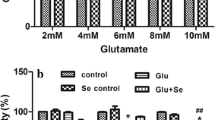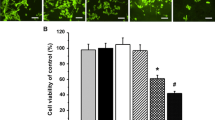Abstract
Resveratrol interacts with the complex III of the respiratory chain, is a radical scavenger and also suppressor of radical formation in the mitochondria. It reduces the intracellular calcium levels in pre- and postsynaptic neurons and also may inhibit the pro-apoptotic factors in glutamate overflow that occurs, e.g. in excitotoxicity. In cell cultures, glutamate overflow leads to formation of free radicals and results in apoptosis. This increase of radical concentration is enhanced by influx of cations like iron or copper ions into the cell. In present study, the beneficial action of resveratrol was investigated in glutamate-affected dissociated cultures of mice mesencephalic primary cultures. On the 10th day in vitro, 5 mM of glutamate was administered for 15 min and the cultures were further maintained in medium containing 0, 0.01, 0.1 or 1 μM of resveratrol. Resveratrol reduced glutamate-induced damages. The number of dopaminergic neurons was increased and their morphology ameliorated when resveratrol followed glutamate treatment. A significant reduction of glutamate-induced radical formation in cultures treated with resveratrol corresponded with a considerable high antioxidative potential of this stilbene determined using the DPPH assay. In addition, ICP-OES was set up to measure the tissues’ copper and iron contents in organotypic cortical cultures of glutamate treated (0 or 30 μM) slices and those in which resveratrol (0, 0.01, 0.1 or 1 μM) was co-administered. Levels of copper were dose-dependently increased, and also the concentration of iron was higher in resveratrol-treated organotypic cultures. The hypothesis that resveratrol has beneficial actions against glutamate damages was verified.







Similar content being viewed by others
References
Alcaraz-Zubeldia M, Rojas P, Boll C, Rios C (2001) Neuroprotective effect of acute and chronic administration of copper (II) sulfate against MPP+ neurotoxicity in mice. Neurochem Res 26:59–64
Belguendouz L, Fremont L, Linard A (1997) Resveratrol inhibits metal ion-dependent and independent peroxidation of porcine low-density lipoproteins. Biochem Pharmacol 53:1347–1355
Blanchet J, Longpré F, Bureau G, Morissette M, Dipaolo T, Bronchti G, Martinoli MG (2008) Resveratrol, a red wine polyphenol, protects dopaminergic neurons in MPTP treated mice. Prog Neuropsychopharmacol Biol Psychiatry 32:1243–1250
Bournival J, Quessy P, Martinoli MG (2009) Protective effects of resveratrol and quercetin against MPP+-induced oxidative stress act by modulating markers of apoptotic death in dopaminergic neurons. Cell Mol Neurobiol 29:1169–1180
Chang Y, Wang S (2009) Inhibitory effect of glutamate release from rat cerebrocortical nerve terminals by resveratrol. Neurochem Int 54:135–141
Chung IM, Yeo MA, Kim SJ, Moon HI (2011) Neuroprotective effects of resveratrol derivatives from the roots of Vitis thunbergii var. sinuate against glutamate-induced neurotoxicity in primary cultured rat cortical cells. Hum Exp Toxicol 30:1404–1408
de Almeida LM, Piñeiro CC, Leite MC, Brolese G, Tramontina F, Feoli AM, Gottfried C, Gonçalves CA (2007) Resveratrol increases glutamate uptake, glutathione content, and S100B secretion in cortical astrocyte cultures. Cell Mol Neurobiol 27:661–668
Forth W, Henschler D, Rummel W, Starke K (1996) Allgemeine und spezielle pharmakologie und toxikologie, 7th edn. Spektrum Akad, Berlin
Frank L, Diemer NH, Kaiser F, Sheardown M, Rasmussen LS, Kristensen P (1995) Unchanged balance between levels of mRNA encoding AMPA glutamate receptor subtypes following global cerebral ischemia in the rat. Acta Neurol Scand 92:337–343
Franke H, Schelhorn N, Illes P (2003) Dopaminergic neurons develop axonal projections to their target areas in organotypic co-cultures of the ventral mesencephalon and the striatum/prefrontal cortex. Neurochem Int 42:431–439
Fukui M, Choi HJ, Zhu BT (2010) Mechanism for the protective effect of resveratrol against oxidative stress-induced neuronal death. Free Radic Biol Med 49:800–813
Gao ZB, Chen XQ, Hu GY (2006) Inhibition of excitatory synaptic transmission by trans-resveratrol in rat hippocampus. Brain Res 1111:41–47
Gille G, Rausch WD, Hung ST, Moldzio R, Ngyuen A, Janetzky B, Engfer A, Reichmann H (2002) Protection of dopaminergic neurons in primary culture by lisuride. J Neural Transm 109:157–169
Had-Aissouni L, Re DB, Nieoullon A, Kerkerian-Le Goff L (2002) Importance of astrocytic inactivation of synaptically released glutamate for cell survival in the central nervous system—are astrocytes vulnerable to low intracellular glutamate concentrations? J Physiol Paris 96:317–322
Jin F, Wu Q, Lu YF, Gong QH, Shi JS (2008) Neuroprotective effect of resveratrol on 6-OHDA-induced Parkinson’s disease in rats. Eur J Pharmacol 600:78–82
Kopp P (1998) Resveratrol, a phytoestrogen found in red wine. A possible explanation for the conundrum of the ‘French paradox’? Eur J Endocrinol 138:619–620
Kuzuhara S, Mori H, Izumiyama N, Yoshimura M, Ihara Y (1988) Lewy bodies are ubiquitinated. A light and electron microscopic immunocytochemical study. Acta Neuropathol (Berl) 75:345–353
Lee SR, Im KJ, Suh SI, Jung JG (2003) Protective effect of green tea polyphenol (−)-epigallocatechin gallate and other antioxidants on lipid peroxidation in gerbil brain homogenates. Phytother Res 17:206–209
Lee MK, Kang SJ, Poncz M, Song KJ, Park KS (2007) Resveratrol protects SH-SY5Y neuroblastoma cells from apoptosis induced by dopamine. Exp Mol Med 39:376–384
Mandel S, Weinreb O, Reznichenko L, Kalfon L, Amit T (2006) Green tea catechins as brain-permeable, non toxic iron chelators to “iron out iron” from the brain. J Neural Transm Suppl 71:249–257
Marques FZ, Markus MA, Morris BJ (2009) Resveratrol: cellular actions of a potent natural chemical that confers a diversity of health benefits. Int J Biochem Cell Biol 41:5–8
Miyazaki I, Asanuma M, Diaz-Corrales FJ, Miyoshi K, Ogawa N (2004) Direct evidence for expression of dopamine receptors in astrocytes from basal ganglia. Brain Res 1029:120–123
Mokni M, Elkahoui S, Limam F, Amri M, Aouani E (2007) Effect of resveratrol on antioxidant enzyme activities in the brain of healthy rat. Neurochem Res 32:981–987
Moldzio R, Radad K, Duvigneau JC, Kranner B, Krewenka C, Piskernik C, Rausch WD (2006) Glutamate-induced cell death and formation of radicals can be reduced by lisuride in mesencephalic primary cell culture. J. Neural Transm 113(9):1095–1105
Oka A, Belliveau MJ, Rosenberg PA, Volpe JJ (1993) Vulnerability of oligodendroglia to glutamate: pharmacology, mechanisms, and prevention. J Neurosci 13:1441–1453
Olanow CW, Tatton WG (1999) Etiology and pathogenesis of Parkinson’s disease. Ann Rev Neurosci 22:123–144
Paris I, Dagnino-Subiabre A, Marcelain K, Bennett LB, Caviedes P, Caviedes R, Azar CO, Segura-Aguilar J (2001) Copper neurotoxicity is dependent on dopamine-mediated copper uptake and one-electron reduction of aminochrome in a rat substantia nigra neuronal cell line. J Neurochem 77:519–529
Pellegrini-Giampietro DE, Gorter JA, Bennett MVL, Zukan RS (1997) The GluR2 (GluR-B) hypothesis: Ca2+-permeable AMPA receptors in neurological disorders. TINS 20:464–470
Plaitakis A, Shashidharan P (2000) Glutamate transport and metabolism in dopaminergic neurons of substantia nigra: implications for the pathogenesis of Parkinson’s disease. J Neurol 247(Suppl. 2):II 25–II 35
Pollanen MS, Dickson DW, Bergeron C (1993) Pathology and biology of the Lewy body. J Neuropathol Exp Neurol 52:183–191
Riederer P, Reichmann H, Janetzky B, Sian J, Lesch KP, Lange KW, Double KL, Nagatsu T, Gerlach M (2001) Neural degeneration in Parkinson’s disease. Adv Neurol 86:125–136
Rodriguez MC, Obeso JA, Olanow CW (1998) Subthalamic nucleus-mediated excitotoxicity in Parkinson’s disease: a target for neuroprotection. Ann Neurol 44(Suppl 1):S175–S188
Shanker G, Aschner M (2001) Identification and characterization of uptake systems for cystine and cysteine in cultured astrocytes and neurons: evidence for methylmercury-targeted disruption of astrocyte transport. J Neurosci Res 66:998–1002
Sherer TB, Betarbet R, Greenamyre JT (2002) Environment, mitochondria and Parkinson’s disease. Neuroscientist 8:192–197
Stanika RI, Pivovarova NB, Brantner CA, Watts CA, Winters CA, Andrews SB (2009) Coupling diverse routes of calcium entry to mitochondrial dysfunction and glutamate excitotoxicity. Proc Natl Acad Sci USA 10:9854–9859
Staub F, Peters J, Kempski O, Schneider GH, Schürer L, Baethmann A (1993) Swelling of glial cells in lactacidosis and by glutamate: significance of Cl−-transport. Brain Res 610:69–74
Sun AY, Wang Q, Simonyi A, Sun GY (2008) Botanical phenolics and brain health. Neuromol Med 10:259–274
Vidavalur R, Otani H, Singal PK, Maulik N (2006) Significance of wine and resveratrol in cardiovascular disease: French paradox revisited. Exp Clin Cardiol 11:217–225
Virgili M, Contestabile A (2000) Partial neuroprotection of in vivo excitotoxic brain damage by chronic administration of the red wine antioxidant agent, trans-resveratrol in rats. Neurosci Lett 281:123–126
Wang XS, Ong WY, Connor JR (2002) Increase in ferric and ferrous iron in the rat hippocampus with time after kainate-induced excitotoxic injury. Exp Brain Res 143:137–148
Wang Q, Yu S, Simonyi A, Rottinghaus G, Sun GY, Sun AY (2004) Resveratrol protects against neurotoxicity induced by kainic acid. Neurochem Res 29:2105–2112
Wong SS, Li RHY, Stadlin A (1999) Oxidative stress induced by MPTP and MPP+: selective vulnerability of cultured mouse astrocytes. Brain Res 836:237–244
Yu AC, Yl Lee, Eng LF (1992) Glutamate as an energy substrate for neuronal-astrocytic interactions. Prog Brain Res 94:251–259
Zini R, Morin C, Bertelli A, Bertelli AA, Tillement JP (1999) Effects of resveratrol on the rat brain respiratory chain. Drugs Exp Clin Res 25:87–97
Author information
Authors and Affiliations
Corresponding author
Rights and permissions
About this article
Cite this article
Moldzio, R., Radad, K., Krewenka, C. et al. Protective effects of resveratrol on glutamate-induced damages in murine brain cultures. J Neural Transm 120, 1271–1280 (2013). https://doi.org/10.1007/s00702-013-1000-6
Received:
Accepted:
Published:
Issue Date:
DOI: https://doi.org/10.1007/s00702-013-1000-6




